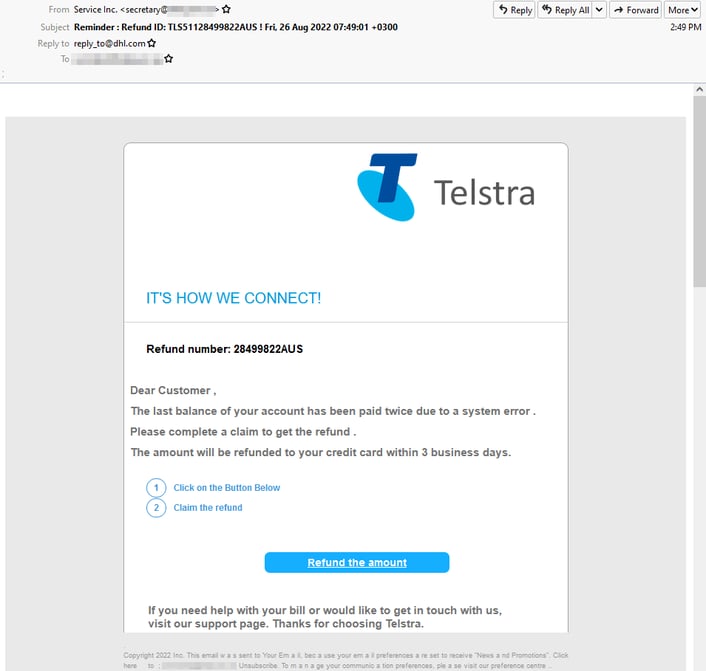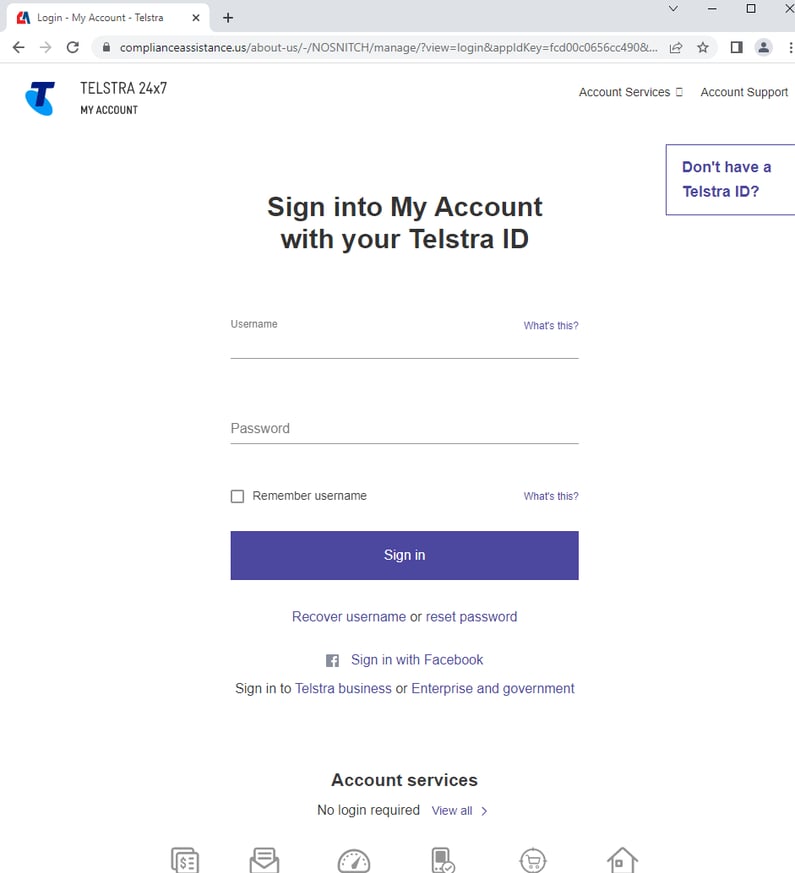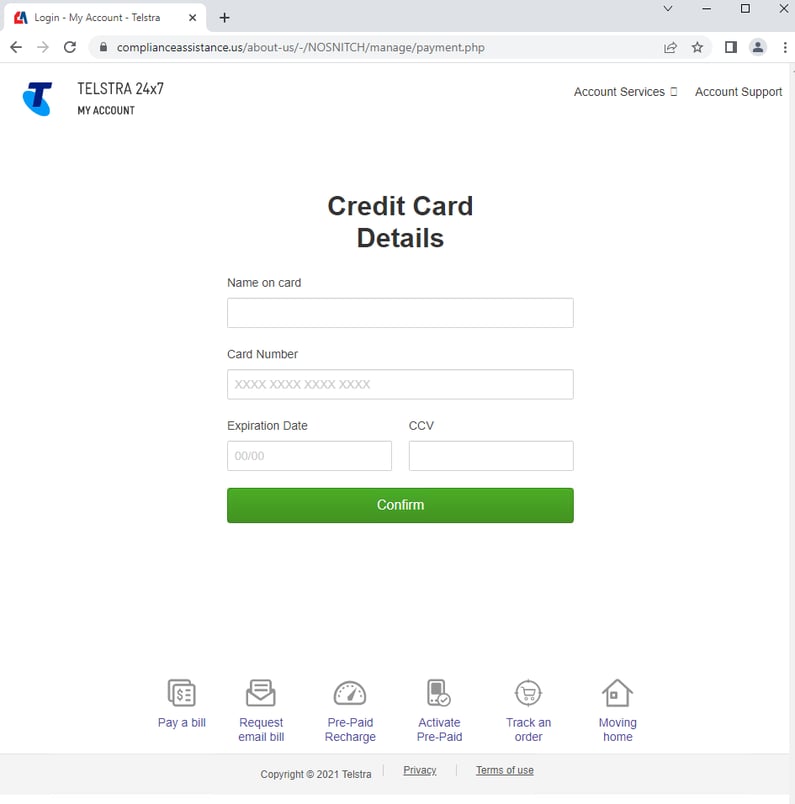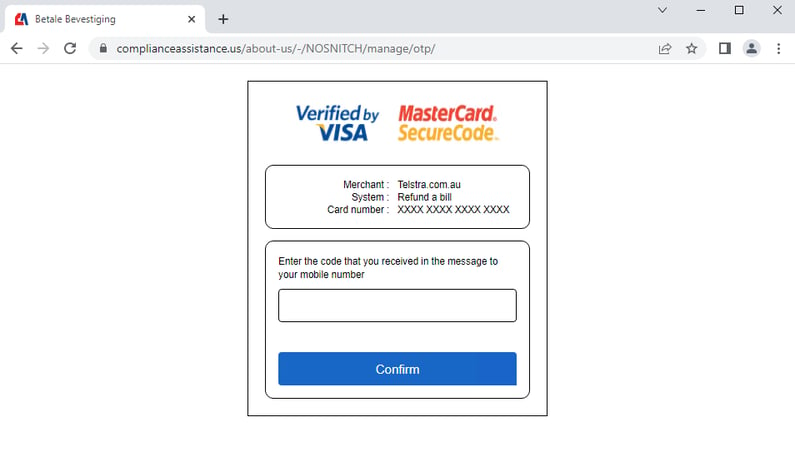Millions of Telstra customers are being targeted in a sinister new phishing scam that promises a refund but aims to steal Telstra ID login information and credit card details.
By gaining access to your Telstra ID account, the fraudster may be able to take control of your phone number and consequently access your bank accounts, in what’s known as a SIM-swap scam. Last year, financial losses to this type of scam cost each victim more than $28,700 on average, with the largest loss totalling $463,782.
The email subject line shows “Reminder: Refund ID: TLS51128499822AUS ! Fri, 26 Aug 2022 07:49:01 +0300”. The sender display name shows “Service Inc.” and the from email address displays as “secretary” at the recipient’s domain, however, the reply-to address is “return(at)dhl(dot)com”, although this does not seem to be a genuine DHL source.
The Telstra-branded email uses a generic greeting of “Dear Customer”, and then alerts the recipient that their account has been “paid twice due to a system error”. In order to get the amount refunded to their credit card, they’re instructed to complete a claim by clicking a button which says, “Refund the amount”.
Here’s what the email looks like:

Clicking the button initially takes the user to a page at “buddys-country-club(dot)fr”, and then redirects to the actual phishing page at “complianceassistance(dot)us”. Both websites appear to have been compromised and are not associated with Telstra.
The phishing page is designed similarly to the login page used by Telstra, and heavily uses their branding. On this page, the user is asked to enter their username and password, which are harvested for later use.

On the next page, which again is craftily designed to appear as a legitimate Telstra site, the victim is asked to enter their credit card details, including:
- Name on card
- Card number
- Expiration date
- CCV

Once the victim has submitted their credit card details, which are also then stolen, they’re redirected to a page which prompts them to enter a one-time code that is sent to their mobile number. If this code is entered, they’re redirected to the genuine Telstra website.

Given that many Australians are presently suffering financially, the promise of a refund may cause them to overlook red flags that we normally warn of, such as the generic greeting, failure to mention the refund total, the DHL reply-to email address, and the incorrect URL.
Telstra are often targets of impersonation in scams due to their trusted name and large customer base. They offer the following suggestions if you have received an email mimicking them:
- Avoid opening suspicious or unsolicited emails – delete them directly from your inbox.
- If you get a suspicious email, don't reply to the email or open the links. If you accidentally click on a link which opens a website, don't enter any information onto the website.
- Avoid opening email attachments. If you've already saved or clicked on an attachment, make sure that your computer’s operating system and anti-virus software is up to date. Consider running an anti-virus scan of your computer.
- Tell us about the scam by submitting a Report Misuse of Service form and include as much detail as you can. Our Cyber Security team will investigate the report and may be in touch if they have additional questions.
MailGuard advises all recipients of this email to delete it immediately without clicking on any links. Providing your personal details can result in your sensitive information being used for criminal activity and may have a severe negative impact on your business and its’ financial well-being.
MailGuard urges users not to click links or open attachments within emails that:
- Are not addressed to you by name.
- Appear to be from a legitimate company but use poor English or omits personal details that a legitimate sender would include.
- Are from businesses that you were not expecting to hear from, and/or
- Take you to a landing page or website that is not the legitimate URL of the company the email is purporting to be sent from.
Many businesses turn to MailGuard after an incident or a near miss, often as a result of an email similar to the one shown above. If unwanted emails are a problem for your business, don’t wait until it’s too late.
Reach out to our team for a confidential discussion by emailing expert@mailguard.com.au or calling 1300 30 44 30.
One email is all that it takes
All that it takes to devastate your business is a cleverly worded email message that can steal sensitive user credentials or disrupt your business operations. If scammers can trick one person in your company into clicking on a malicious link or attachment, they can gain access to your data or inflict damage on your business.
For a few dollars per staff member per month, you can protect your business with MailGuard's predictive and advanced email security. Talk to a solution consultant at MailGuard today about securing your company's inboxes.
Stay up-to-date with MailGuard's latest blog posts by subscribing to free updates. Subscribe to weekly updates by clicking on the button below.







